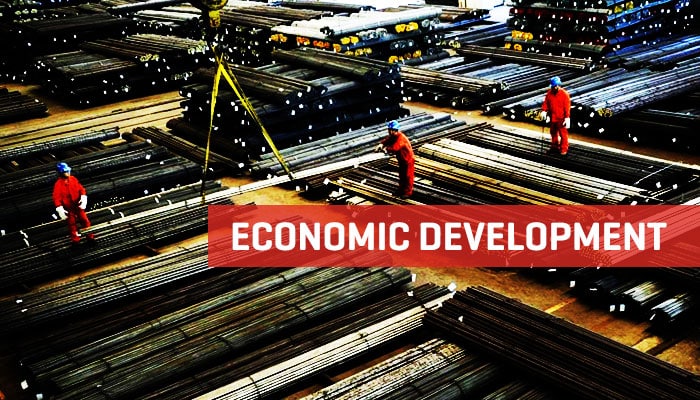Making Economic Development Work in Uncertain Times

The final months of 2016 were bleak for those with an outlook on the economy. U.S. growth rates in early 2017 shrank to a five-year low of 1.6 percent, making 2015’s and 2014’s totals — 2.6 percent and 2.4 percent, respectively — look robust.
The most recent figures were alarming for most, but they can’t really be considered surprising. If there’s one thing business hates, it’s uncertainty. A long-running theory holds that companies tend to keep their checkbooks pocketed during presidential election cycles. If there’s any validity to that assertion, the recent election season would have been a case study on creating doubt.
We can hardly call the early months of 2017 business as usual, but that does not mean ongoing uncertainty will continue to compromise the U.S. economy. If you look beyond simple growth rates and focus on more refined indicators of growth and C-suite confidence, there is a lot to be optimistic about.
Put Economic Development Into Proper Perspective
The term “economic development” means different things to different people. Generally, anyone looking for your support will couch it in terms of economic development, but the actual advancing of a local economy’s interests and basic boosterism aren’t the same thing.
In my world, economic development is working with businesses to help them find solutions to their most pressing problems in a manner that benefits the surrounding community. The focus is on finding mutually beneficial solutions rather than funneling as much money as possible to a specific location.
Expansion is a data-driven process with a lot of inherent risk. This is compounded by the fact that many developers are working with brief timelines and might have already fallen behind schedule. There are serious consequences if the wrong site is chosen, but the compressed timelines at play make it essential that the right data are available to be analyzed in a way that minimizes risk as much as possible.
One of my primary goals as an economic developer is to reduce this risk as broadly as possible. We can do this by coordinating statewide with utilities, government agencies, transportation infrastructure providers, workforce developers, and more to deliver custom solutions to the companies we are working with.
The full range of these services is important to understand because it highlights the difference between robust growth and quality growth. Rather than taking steps to bring the maximum number of companies to the area as quickly as possible, we put in the work to ensure an expansion or relocation is the best fit for all. Companies begin development feeling confident that the location is right, that the local workforce can fill staffing needs, and that long-term value is attainable.
This conception of economic development might not always lead to skyrocketing growth rates year after year. But it does lead to stable, sustainable periods of growth that are more immune to uncertainty and disruption. That may not be the kind of development that boils the economic waters, but its the kind that all business leaders should realistically aspire toward.
Applying the Lesson of Gradual Growth
Avoiding the urge to rush forward as quickly as possible is not easy for some companies and communities. Luckily, it does not require a complete shift in thinking; it simply requires decision makers to aim their focus, provision their resources, and focus on the long game. Here are some lessons I have learned about making economic development work for more stakeholders over a longer period:
- Eliminate every risk. Think of unknowns as unacceptable. If you are staking your name and professional reputation to a particular plan, take every step necessary to explore and address the potential risks.
Until you have, you will either proceed forward recklessly or hold back because of unnecessary caution. Exploring unknowns and eliminating risks is not an easy thing to do, but it’s the only way to put big plans in action and not saddle them with uncertainty.
- Consider the community. It’s easy for expansion plans to become an overwhelming array of facts and figures. This systematic approach to site selection obscures the fact that every expansion takes places in a real community filled with actual people.
Qualities of this community that may not be easy to express metrically will ultimately dictate the success or failure of the project. For reasons of expediency, companies are understandably eager to eliminate sites from consideration. Just be sure not to eliminate locations for reasons related to short-term cost cutting rather than long-term feasibility.
- Expect high-level service. Economic development is a two-way street. Decision makers should feel confident the sites they choose will deliver as much value as the company will deliver in return.
Economic development professionals who make concerted efforts to answer questions, address concerns, make accommodations, and seek solutions make the best long-term partners. These economic development partners understand what it takes to form a lasting, mutually beneficial relationship, and they are willing to marshal every resource to enhance the partnership.
In a time of uncertainty, it’s essential for enterprises to control what they can. Where, when, and how they choose to expand is one such decision. Rather than rushing to break ground, adopt a more measured understanding of economic development and take advantage of the long-term stability that follows. It’s the informed way to approach the unknown.
Bring the best of the CEOWORLD magazine's global journalism to audiences in the United States and around the world. - Add CEOWORLD magazine to your Google News feed.
Follow CEOWORLD magazine headlines on: Google News, LinkedIn, Twitter, and Facebook.
Copyright 2025 The CEOWORLD magazine. All rights reserved. This material (and any extract from it) must not be copied, redistributed or placed on any website, without CEOWORLD magazine' prior written consent. For media queries, please contact: info@ceoworld.biz








